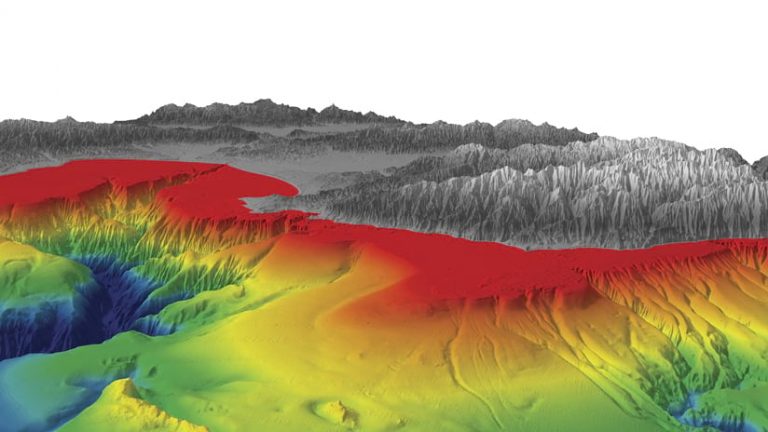A New Academic Discipline Confronts Vast Technological Advancements
Throughout the 20th century, the field of cartography experienced many shifts that molded the art, science, and practice of mapmaking into a concrete academic discipline, complete with its own rationale, methodologies, and research. The back half of the century also introduced robust new technology to the process, including computer-assisted cartography and GIS. While some innovations in mapping initially overshadowed the principles of cartography that took decades and even centuries to form (see my last ArcNews column, “The Early Evolution of Cartography”), cartography has benefited from the increased availability of data and the expanded capacity to map just about anything.
Cartography Becomes a Bona Fide Academic Discipline
In the United States and Canada, formal training in cartography began in earnest in the 1940s. Academic programs were set up at just a few universities at first, and they were centered on individual cartographers who largely taught mapmaking techniques. But after World War II (WWII), universities began establishing more recognizable courses of study in cartography with dedicated faculty and postgraduate programs.
As the formalized study of cartography expanded at the postsecondary level, other developments in the field took hold. The growing number of professors, students, and practitioners started forming their own national cartographic societies, which convened meetings and conferences and even published their own professional journals, newsletters, and other publications.

While many people contributed to the expansion of cartography as an academic discipline, two cartographers stood out: Eduard Imhof from Switzerland and Arthur Robinson from the United States. They both wrote extensively about cartography, established early national cartographic societies, and presided over the International Cartographic Association (ICA) at different times.
Imhof, a renowned mountain cartographer, founded Switzerland’s first academic center for cartography at the Federal Institute of Technology in 1925. Early emphasis at the institute was on representing the earth’s surface using design concepts—that is, applying an artistic approach to relief mapping that maintained positional accuracy. Robinson, who taught at the University of Wisconsin-Madison from 1945 to 1980, was instrumental in developing cartography as an academic discipline not only in the United States but also around the world. His Elements of Cartography textbook has been widely used for decades, and he helped establish The American Cartographer, the first American journal of cartography.
Cartography in North America was strongly tied to academic programs in geography, which focused more heavily on thematic cartography than on the mathematical aspects of mapping, apart from map projections. Topics in geography are broad, however, and that discipline tends to use maps to tell the story of various subjects. On the other hand, cartography programs in Europe often focused more directly on the basemap, beginning with the topographic map. Additionally, academic programs at some institutions showed how cartography was related to other, similar fields such as surveying, remote sensing, photogrammetry, and air photo interpretation. These programs typically focused on topographic science within a larger geography department.
Technological Advances Change How Cartographers Make Maps
Accompanying the development of cartography as an academic discipline were big changes to how people made maps.
Prior to WWII, mapmakers produced maps largely on paper, whereas after, they began using a more stable base material: plastic. This made it possible to employ new photomechanical techniques during the production process that allowed cartographers to decrease the scale of a map while still providing sharp image results. Some mapmakers used scribers to produce high-quality map engravings on the new, more durable material. Thus emerged a new labor category: skilled cartographic draftsmen.
This period only lasted a few decades, though, before the art form encountered the computer age. At every turn in the history of cartography, the goal was to make high-quality products that were not only functional but also pleasing to the eye. It was initially unclear if computers could replicate these tenets of cartography—especially since their automated tasks and processes added pressure on cartographers to make more maps in less time.
In the early days of computer-assisted cartography, the objective was to use the machine to perform as many functions as possible. Repetitive actions that were previously done by hand—like engraving—gave way to line-following devices and scanning technologies. This allowed large volumes of data to be processed automatically, which saved time and reduced errors. So cartographers were able to continue focusing on producing highly effective and well-designed maps.
That said, this joint effort between human and machine was not a natural fit. Several assumptions about this new relationship have never been realized. One was that automation would reduce the cost of mapmaking. However, having to invest in new technologies and skilled labor is still costly.
There was also a view in the early days of automation that the machine could never produce the same quality of maps that a professional cartographer could, both in terms of the artistic work that cartographers do and the decision-making processes they go through to choose content and represent it in different ways. This may have been true for a while—programming ones and zeroes into early computer programs rarely produced accurate lines on maps, and early plotters yielded images that were low resolution and off-color. But it was only a matter of time before these technical limitations improved considerably.
GIS Brings New Users to Mapmaking but Not Without Drawbacks
While automated cartography was advancing, the use of a parallel technology—GIS—was expanding as well.
In the 1990s, GIS started to overshadow the field of cartography as the focus of making maps shifted from following traditional cartographic concepts to producing geographic visualizations of data. There are drawbacks to that, though. Someone without a background in cartography only has to try to make a map once to realize how difficult it is to produce a well-designed cartographic representation that successfully communicates the intended message. For example, while there is a GIS tool that lets users choose different types of cartographic symbols for a map, picking the best symbol to portray data in a compelling visual and narrative style isn’t a straightforward or simple task. This is also true for selecting what content should appear in a map and how the map visualization should work.
The automation that GIS provides was developed to meet users’ expectations as well, which was a shift in the prior practice of offering standard map products. These were not easy requirements to meet, however, especially because the GIS user base was continually expanding into new disciplines, including business, health, education, and urban planning. For cartography, though, the technology’s growth in other disciplines ended up providing fresh mapmaking opportunities.
Substantial Developments Alter Cartography Forever
Over the course of the 20th century, and especially in the latter decades, the field of cartography changed dramatically. It came into its own as an academic discipline and was pushed to new extents thanks to the emergence of several cartographic societies. As mapping technology developed, the job of a cartographer moved into new realms, and the principles of cartography took on greater importance, even if sometimes they were eclipsed by new mapping tools. Ultimately, being able to bring together data on any topic—and map it—elicited many cartographic innovations, and that has benefited countless disciplines, including cartography.


